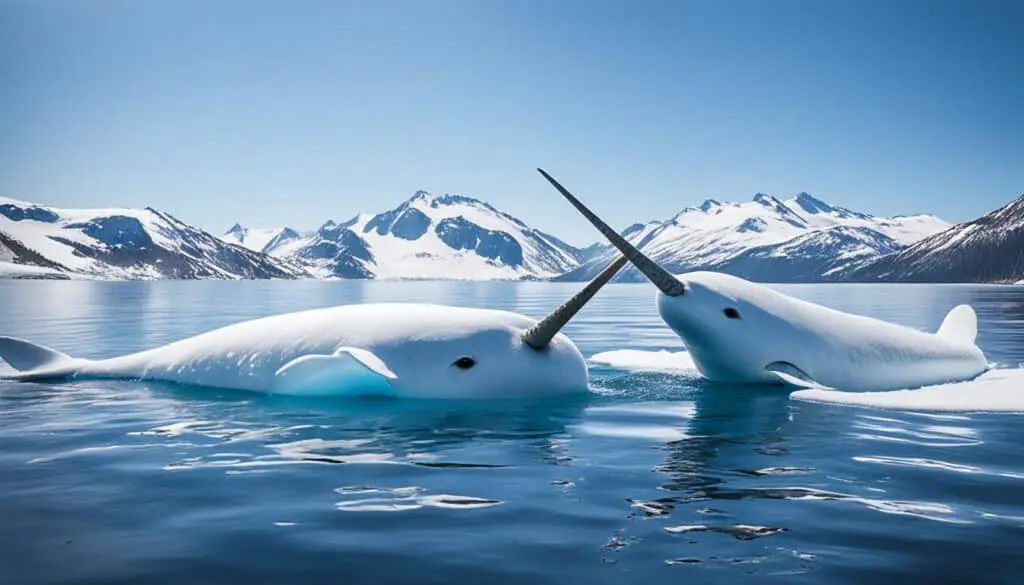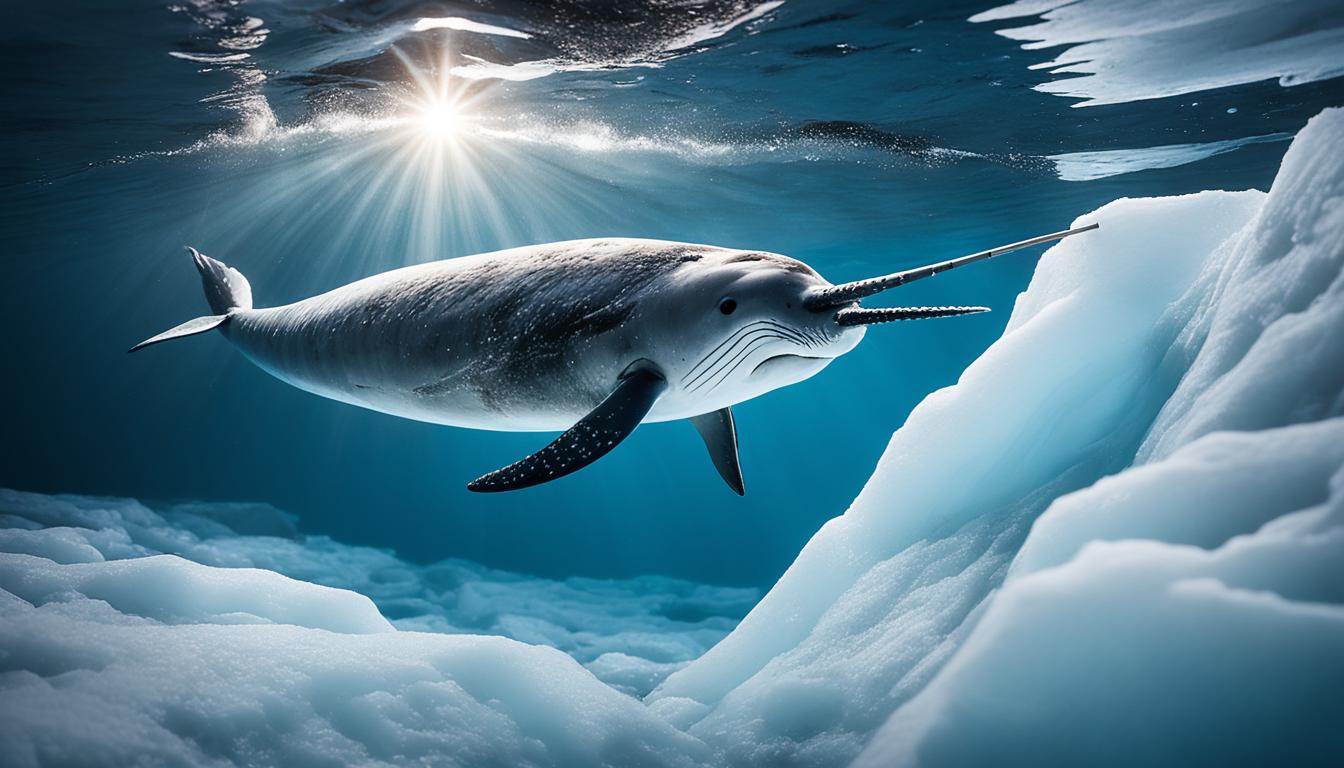Narwhals have amazing skills that help them move under the Arctic ice. They use breathing holes and ice cracks as key guides. These abilities are crucial for finding food and avoiding danger.
Learning about narwhal navigation under ice shows how vital these skills are. They need these skills to survive, especially when they move to less icy areas. This journey is key to their survival.
Exploring narwhal movement under ice reveals how they live in a tough environment. It shows how their unique ways of moving under ice define their life.
The Arctic Habitat of Narwhals
The Arctic home of narwhals is both beautiful and tough, with frozen lands and icy seas. These marine animals live in ice habitats that are ideal for them. They move around based on the ice changes, which helps them find food, meet others, and live their lives.
Location and Migration Patterns
Narwhals live in Arctic waters around Canada, Greenland, and Russia. They move based on where the ice melts in spring. Most narwhals spend winter in places like Baffin Bay and the Labrador Sea, where they can hunt.
When the ice melts, they move north to the Canadian Arctic. They follow paths that match the ice patterns.
Seasonal Changes in Ice Coverage
Ice coverage changes with the seasons and is key for narwhals. In winter, most of the Arctic is frozen, making it hard for them to hunt and move. But they adapt, changing their ways to find food and friends in this changing world.
| Season | Ice Coverage | Migration Patterns |
|---|---|---|
| Winter | Approximately 90% ice | Large populations in Baffin Bay, Davis Strait |
| Spring | Ice recedes drastically | Northward migration into Canadian Arctic |
| Summer | Varied ice coverage | Exploration of new feeding grounds |
| Fall | Formation of new ice | Return migrations to winter habitats |
How do narwhals navigate under ice?
Navigating icy waters is tough for narwhals. They have amazing strategies to live in the cold. These strategies show how they adapt and survive.
Utilization of Breathing Holes
Narwhals need breathing holes to get air under the ice. These holes can be far apart, making their journey tough. They use special swimming skills to move between these holes. This is key to their survival, especially on long dives.
Memory and Experience in Navigation
Remembering where breathing holes are helps narwhals navigate. Over time, they learn the best routes and where to find air. They also share info with each other, like where to go and find air, which helps everyone.
| Technique | Description | Importance |
|---|---|---|
| Narwhal Ice Swimming Techniques | Efficient swimming methods to travel between breathing holes. | Vital for accessing air and avoiding ice traps. |
| Narwhal Breathing Holes | Openings in the ice used for surfacing to breathe. | Essential for survival during long dives. |
| Narwhal Navigation Strategies | Mental maps developed through experience and memory. | Facilitates safe and efficient travel in icy waters. |
| Underwater Ice Travel | Movement beneath the ice sheet to reach feeding or breeding areas. | Critical for accessing necessary resources in extremely cold environments. |
Physical Adaptations to Arctic Conditions
Narwhals live in the harsh Arctic thanks to their amazing physical changes. These changes help them move through icy waters with ease and efficiency.
The Role of No Dorsal Fin
Not having a dorsal fin is a key feature of narwhals. It helps them swim quietly under ice. Without a dorsal fin, narwhals stay warmer in the cold Arctic. They can move through tight spaces and thick ice better.
This helps them survive, especially when avoiding predators and finding food.
Streamlined Bodies for Efficient Movement
Narwhals have bodies that are shaped for fast movement in the water. Their streamlined shape lets them move smoothly through icy waters. They can dive deep to find food.
This shape cuts down on drag, saving energy while swimming. Under the ice, being agile and strong is key for finding food.
Social Interactions and Communication
Narwhals have unique ways of navigating and surviving together. They use narwhal whale communication to stay connected. This includes making different sounds to talk to each other.
They use whistle calls to move together as a group. This is especially important in the spring when many narwhals meet up.
Whistle Calls for Coordination
Narwhals use their whistles to stick together and work as a team. Each whistle call helps them plan their actions. This is crucial in the icy waters of the Arctic.
Building Social Connections Among Pods
Narwhals form strong social bonds that help them survive. These bonds are built through talking and working together. They affect who gets to use resources and find mates. This social structure is vital for doing well in the tough Arctic environment.

| Social Behavior Aspect | Description |
|---|---|
| Whistle Calls | Primary method of communication for coordination among pod members. |
| Pod Dynamics | Structure and organization within pods facilitate group survival. |
| Social Bonds | Strong relationships enhance access to resources and mating opportunities. |
| Arctic Adaptation | Utilization of social skills to navigate and thrive in harsh conditions. |
Narwhal Ice Diving Behavior
Narwhals have amazing diving skills that help them survive in icy waters. These skills show how they adapt and behave in a tough environment.
Depth and Duration of Dives
The depths of narwhal dives can go as deep as 1,500 meters (about 4,920 feet). They can stay underwater for up to 25 minutes. This deep diving is key for finding food that’s hard to reach near the surface.
Seeking Food in Frozen Waters
Narwhals use special narwhal foraging techniques to find food like halibut, squid, and shrimp. They dive deep to get to narwhal food sources in ice that are hidden. This way, they can find food rich in nutrients, which helps them survive.
| Aspect | Details |
|---|---|
| Maximum Dive Depth | 1,500 meters (4,920 feet) |
| Average Dive Duration | Up to 25 minutes |
| Common Food Sources | Halibut, squid, shrimp |
| Foraging Techniques | Deep diving, echolocation |
Predator Avoidance Strategies
Surviving in the Arctic is not just about finding food. Narwhals have smart ways to avoid predators. They use the icy habitat to stay safe from orcas and polar bears. This helps them hide and increases their chances of living in a tough place.
Using Ice as a Shield
Narwhals use ice to hide from predators. Their body shape, without a dorsal fin, lets them move easily under the ice. This makes it hard for predators to see them, helping them stay hidden when it matters most.
The thick ice layers are perfect cover. Narwhals can stay hidden and check out the situation without being seen.
Behavioral Responses to Threats
Narwhals also have special behaviors to stay safe. When they sense danger, they dive quickly to get away from predators. These actions help them avoid danger and show how adaptable they are to their harsh environment.
FAQ
How do narwhals navigate under the ice?
Narwhals use natural features like breathing holes and ice cracks to move through the ice. They’ve learned to rely on these spots to find food and avoid danger.
What role do breathing holes play in narwhals’ navigation?
Breathing holes are key for narwhals as they let them breathe at the surface. They can travel far between these holes. Remembering where they are is key to navigating the icy waters.
How do narwhals use social communication during navigation?
Narwhals use sounds and tusk rubbing to talk to each other. They share info on the best paths and where to find air holes. This helps them move through the ice together.
What physical adaptations help narwhals navigate under ice?
Narwhals don’t have a dorsal fin, which helps them sneak under the ice without losing heat. Their sleek body shape also helps them move easily through the ice.
What depths can narwhals reach when diving under the ice?
Narwhals dive as deep as 1,800 meters (5,905 feet) to find food. This lets them get to different food sources, which is key to surviving in icy waters.
How do narwhals avoid predators in the Arctic?
Narwhals hide under the ice to avoid predators like orcas and polar bears. Their skills and the ice help them stay safe while they look for food.
What are the seasonal migration patterns of narwhals?
Narwhals move north to the Canadian Arctic as the ice melts in spring. They follow certain paths based on ice conditions. These paths are important for their survival, eating, and social life.
What impact does climate change have on narwhal navigation?
Climate change changes narwhals’ ice homes, affecting how they move and find food. As the ice shifts, narwhals might struggle to find air holes and food spots.







